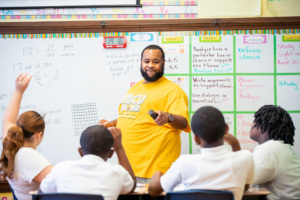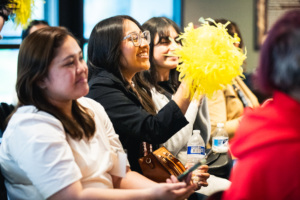Residency program
The residency program, which began in 2017 and partners with five prep programs (four universities and Relay Graduate School of Education), now prepares over 200 teachers a year, serving as an invaluable preparation and recruitment strategy for the district. Many of the residents come from within CPS itself; about two-thirds were already working for the district, often as paraprofessionals or in similar roles, and many graduated from the district or have children attending CPS schools.

The residency program comes with several financial benefits for new teachers. Residents earn a $40,000 salary plus benefits during their year of student teaching (first-year teachers in the district make $64,000). Residents also begin on the second step of the salary schedule (since their residency year is counted as a year of teaching), and they can carry up to five years of employment with them, allowing them to begin as far up on the salary schedule as the sixth step. Also, a majority of residents earn their master’s degree after their residency year, placing them on the second lane of the salary schedule (or potentially higher if they enter with other graduate coursework).
The residency is very much designed with the hiring needs of the district in mind, only preparing people for high-need subject areas and focusing placements in priority schools. (Priority schools are identified based on an “opportunity index,” considering schools that may be harder to staff, based on vacancy and retention rates, geographic location, truancy rates, and other data; about 65% of schools in the district are deemed a priority).

To identify mentor teachers, CPS has a bank of over 200 mentor teachers from the district. The district considers mentor teachers’ years of experience and evaluation ratings when vetting teachers. Every resident and mentor fills out a profile about themselves and what they’re looking for, then shares profiles with the district. CPS uses this information to create “match banks” in Google spreadsheets, which include information about all residents and mentors in each content area track. Each mentor or resident is asked to have five conversations—they can each reach out to whomever they identify over the course of a month (e.g., have a phone call, meet in person or virtually, grab coffee), and after meeting they complete an exit ticket (with a scale of 1–5 about how much they want to be with the mentor or resident). The district makes the matches, aiming to match high scores on the exit ticket while also considering whether the placement sites are priority schools.

Mentor teacher training comprises a two-day orientation in the summer, as well as mandatory quarterly in-person meetings (during which residents cover the classroom). Also, the district requires mentors to complete guidance documents on a near-monthly basis. With these documents, mentors set growth goals with their residents, assess them on the Danielson Framework, and plan and focus the residents on growth areas. If a mentor is having challenges with a resident, staff from the CPS Office of Teaching & Learning provides them additional support, either observing and meeting with the mentor to set up a coaching plan or having a virtual support and coaching meeting with them. The CPS team also provides training to some mentors to become coaches for other mentors.
Traditionally prepared student teachers
Previously, the district had no dedicated student teaching team to help support traditionally placed student teachers, a gap they addressed in early 2023 through the creation of the student teaching team. Now Katie Thomson, student teaching program manager, and two teammates manage the program from the CPS central office. They have drawn lessons from the success of the district’s residency program, though they have modified some of the residency’s placement approaches to accommodate the scale of student teaching—over 1,000 student teachers come through CPS each school year.
The team developed both a preservice teaching application and an application for school leaders to complete when they are interested in hosting student teachers in their building. The team also collects information about potential cooperating teachers, looking for those with strong ratings from their principals, positive student outcome data (although the pause in student testing during the pandemic has limited the availability of that data), strong interest in becoming a mentor teacher, and experience in the district.
To track student teaching placements across the district, the team uses Salesforce (which can help them pull reports based on the data they collect). Training for cooperating teachers is conducted by the Office of Teaching and Learning, which employs training specialists who conduct professional development and which has a bank of cooperating teacher training resources. Training topics include culturally sustaining pedagogies; historical experiences of students of color in education; tapping into students’ community cultural wealth, funds of knowledge; and teaching and learning for equal access.
Placements focused on priority schools

CPS has developed an initiative for a subset of student teachers called the Pre-Service Teaching Equity Project (or P-STEP). The program, which received federal grant funding, partners with six local teacher prep programs with a focus on placing student teachers in high-need schools, disrupting the status quo of institutions partnering with familiar (and often higher-income) schools in the district. P-STEP offers additional training for cooperating teachers grounded in the principles of equity. It also offers additional support for student teachers, including more one-on-one attention, professional development, a subscription to the Teaching Channel, tutoring for licensure tests, resumé workshops, and earlier opportunities to apply for jobs in the district.
While the district has not yet been able to directly place all student teachers (meaning that in some cases, candidates or their prep programs set up the placements), CPS takes several approaches to support matches, including setting up informal introductory calls between candidates and potential cooperating teachers, allowing them to determine if the match would be a good one.

CPS prioritizes placing student teachers in higher-needs schools. The district has built an “opportunity index” where schools are ranked on a number of criteria that measure whether they are more affluent or more disinvested (including student demographics, neighborhood metrics, and historical funding). The district is working on increasing the number of student teachers placed in these high-need schools. Currently all P-STEP candidates are in high-need schools, and on average about 60% to 70% of all student teaching placements are in high-need schools.
Funding
The district has found multiple ways to fund the focus on student teaching. First, the staff built buy-in with the district’s leadership to use student teaching to build a stronger, more diverse pipeline of teachers into the district who would stay longer. Next, the Talent Office was able to identify ways to fund some of the work internally, such as using money that would go toward vacant positions to repurpose for the student teaching initiatives. Further, local philanthropic partners have invested in the residency. Also, CPS has won federal grants such as the Teacher Quality Project.
“We apply for lots of grants, and we win many of them because we’ve been able to develop such a compelling narrative with our Teach Chicago initiative. This work is so compelling because it is all part of a broader strategy, so it feels coherent and aligned.”Ben Felton, chief talent officer
Strategic focus on hiring
Because an impetus for focusing on student teaching was to build the pipeline of teachers into CPS, especially into hard-to-staff schools, hiring is a consideration throughout the programs:
- When principals complete a preservice application to host student teachers, they indicate the grades or subjects in which they anticipate openings and can look for student teachers specifically in those areas.
- Student teachers in the P-STEP program have earlier access to hiring fairs and opportunities to work in the district, especially if they’re seeking certification in a high-need subject area. They also have more opportunities for professional development and one-on-one support, as well as individual guidance from recruiters.
- Residents are not only placed in harder to staff schools, but also have a window of time when they can only accept job offers from high-need schools.
Outcomes
The program monitors progress while residents are in the program through the quarterly forms and action plans that cooperating teachers complete in collaboration with the residents. These forms offer insight into cooperating teachers’ level of participation and their residents’ growth. CPS also monitors residents’ outcomes through surveys of residents, mentors, alumni, and principals.
The goal of the residency program is largely to recruit from within Chicago so that resident teachers are both more diverse and invested in the district and so likely to stay. The admissions data shows they are meeting that goal: two-thirds of residents previously worked with the district (e.g, as paraprofessionals), two-thirds are people of color, and many have children in CPS or have graduated from CPS.
The district is also pleased by the retention data for their residents. Across the district overall, 50% of teachers leave in five years; for residents about 88% stay for five years (and hopefully longer). The teachers coming through the residency program are similarly effective compared with traditionally prepared teachers and are more likely to work in higher-needs schools.
In the future, CPS intends to look at how this program has impacted the vacancy rate in the highest-needs school.
Across the broader student teaching program, the district is already seeing a shift in where student teachers are placed, with more people working in hard-to-staff schools.
Advice
- Invest school leaders in making student teaching a priority: Part of this is making clear the value proposition for each group and helping them see how they (their school, their prep program) will benefit from this approach to student teaching.
“School leaders have a thousand things to do—investing them in this is important but hard… I think it’s hard to convince them that people from Central Office are there to help. It takes work to build credibility and relationships so schools trust you and want to work with you.”Ben Felton, chief talent officer
- Build relationships among the district and prep programs: The district regularly holds meetings with university coordinators to take feedback on the process, what’s working, and what needs to be changed.
- Invest in people who are already in the district: People already working in the district or involved with the CPS school system are already familiar with the challenges and the upsides of the district and are more likely to want to stay in the system.

